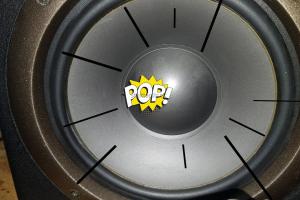Reviving Your Sound: A Complete Guide to Unpopping a Speaker Cone

-
Quick Links:
- Introduction
- Understanding Speaker Cones
- Common Causes of a Popped Speaker Cone
- Diagnosing the Issue
- Step-by-Step Guide to Unpop a Speaker Cone
- Case Studies
- Preventative Measures
- Expert Insights
- Conclusion
- FAQs
Introduction
Speaker cones are essential components of audio equipment, responsible for producing sound by converting electrical energy into mechanical energy. Over time, these cones can suffer damage, leading to a phenomenon commonly referred to as "popping." This article will guide you through the process of unpopping a speaker cone effectively, ensuring your audio quality remains intact.
Understanding Speaker Cones
Speaker cones, typically made of paper, plastic, or metal, vibrate to produce sound waves. The cone's movement is crucial for sound fidelity, and any damage can result in distortion or loss of sound quality. Understanding the anatomy of a speaker cone is vital for effective troubleshooting:
- Diaphragm: The main surface that vibrates to create sound.
- Surround: The flexible ring that connects the diaphragm to the frame.
- Voice Coil: The component that converts electrical signals into mechanical movement.
Common Causes of a Popped Speaker Cone
Several factors can lead to a popped speaker cone, including:
- Overdriving: Playing audio at excessively high volumes can strain the cone.
- Physical Damage: Direct impacts or environmental factors can cause tears.
- Age and Wear: Over time, materials can degrade, leading to failures.
Diagnosing the Issue
Before proceeding with any repairs, it’s crucial to diagnose the issue accurately. Here’s how:
- Visual Inspection: Check for any visible damage to the cone.
- Sound Test: Play different frequencies to identify distortion.
- Check Connections: Ensure that all wiring is intact and properly connected.
Step-by-Step Guide to Unpop a Speaker Cone
Follow these steps to successfully unpop a speaker cone:
- Gather Your Tools: You will need a soldering iron, adhesive, and replacement materials if necessary.
- Disassemble the Speaker: Carefully remove the speaker from its housing.
- Assess Damage: Determine if the cone is repairable or needs replacement.
- Repair the Cone: Use adhesive to fix minor tears or replace the cone if necessary.
- Reassemble: Put the speaker back together, ensuring all parts are secure.
- Test Sound Quality: Play a variety of audio to ensure the repair was successful.
Case Studies
Here are a few real-world examples of successfully unpopping speaker cones:
Case Study 1: The Overdriven Bass
A user reported a popping sound during heavy bass tracks. After inspection, it was found that the cone had a minor tear. Using adhesive, the user successfully repaired the cone, restoring audio fidelity.
Case Study 2: Environmental Damage
Another case involved a speaker left in humid conditions, causing the cone to warp. Replacement of the cone material was necessary, but the sound quality returned to normal after reassembly.
Preventative Measures
To avoid future issues, consider the following precautions:
- Avoid playing music at excessively high volumes.
- Store speakers in a controlled environment with minimal exposure to moisture.
- Regularly check and maintain speaker components.
Expert Insights
Industry experts recommend regularly servicing audio equipment to prolong its lifespan. Preventative maintenance can save you from costly repairs down the line.
Conclusion
Unpopping a speaker cone is a straightforward process that requires careful attention and the right approach. By understanding the components and causes of damage, you can effectively restore your audio equipment, ensuring high-quality sound for years to come.
FAQs
1. Can I repair a popped speaker cone myself?
Yes, with the right tools and techniques, many speaker cones can be repaired at home.
2. What are the signs of a popped speaker cone?
Common signs include distortion, buzzing sounds, or visible damage to the cone.
3. How do I know if my speaker cone needs replacing?
If the damage is extensive or the cone is warped beyond repair, replacement may be necessary.
4. Are there professional services for speaker repairs?
Yes, many audio repair shops offer professional services for speaker repairs and maintenance.
5. How can I prevent my speaker cone from popping?
Avoid overdriving your speakers and keep them in appropriate environmental conditions.
6. What types of adhesive should I use for repairs?
Use a strong adhesive designed for speaker materials, such as rubber cement or specialized speaker glue.
7. How long does a typical repair take?
Repairs can take a few hours, including drying time for adhesives.
8. Is it worth repairing an old speaker?
It often is, especially if the speaker has sentimental value or high-quality components.
9. Can a popped speaker cone cause further damage?
Yes, ignoring a popped cone can lead to more significant issues with the speaker's overall functionality.
10. Where can I find replacement parts for my speaker?
Replacement parts can often be found at audio equipment retailers or online marketplaces.
For further reading and resources, check out:
- How to Repair a Speaker Cone - Sound Guys
- Speaker Repair Tips - Audioholics
- DIY Speaker Repair - Parts Express
Random Reads
- How to program dish network remote
- How to recover data from dead laptop
- How to recover deleted history in windows
- How to use gimp
- How to use google calculator
- Stay safe from hackers
- Speed up steam downloads
- Open applications terminal mac
- New article boosting requirements testing
- How to write in hindi in microsoft word